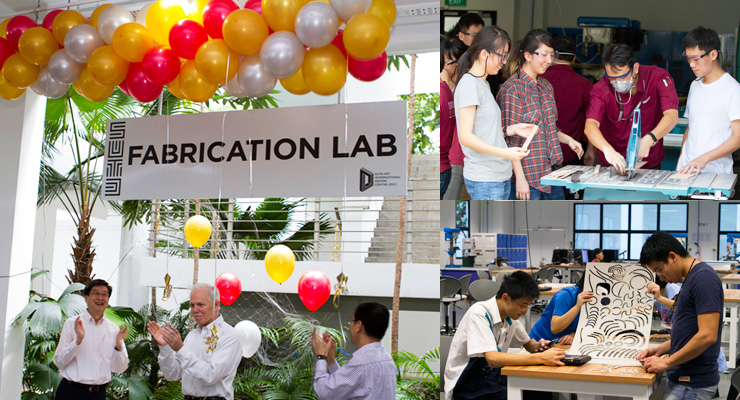SUTD Unveils Fabrication Laboratory for Educational and Professional Practice
The Singapore University of Technology and Design (SUTD), established in collaboration with MIT, opened a new facility at its interim campus today ─ a multidisciplinary fabrication laboratory. The 1,000 sqm laboratory is modelled after MIT’s Pappalardo Lab, one of the fabrication laboratoriesat MIT that aims to allow students to design and build virtually “almost anything”.Faculty, researchers and students are able to access valuable expertise and resources to transform their creative ideas into tangible products, and eventually, into meaningful outcomes and innovations to serve societal needs.

The fabrication laboratory is also designed to cater to the needs of the SUTD-MIT International Design Centre (IDC), a research design centre of SUTD and MIT with facilities at both universities, in Singapore and MIT in Cambridge. IDC faculty researchers and students from the two universities will work together to address issues through design science research and designing devices, systems and services to meet the needs of Singapore, its neighbours, the United States and the world.
SUTD President Professor Thomas Magnanti said: “The Fab Lab supports SUTD’s strong interdisciplinary design-focused pedagogy that emphasises theory and practical work. With the opening of the Fab Lab, our students will be engaging in project-based hands-on learning to make their imagination a reality.”
The laboratory at SUTD not only caters to the engineering projects, but also the architectural projects. Students in the first year of curriculum will make use of basic level equipment and tools such as table saws, 3D printers and laser cutters for design projects. As they progress, they will be using the Lab to produce more advanced prototypes to showcase their entrepreneurial ideas.
Equipped with a complete range of fabrication equipment and tools for metal/wood work, digital fabrication, an electronics lab and a large project area where students can work on projects ─ assembly, testing, discussions, show and tell, and more ─ the laboratory allows students to make “almost anything”.This ability of turning any concepts and ideas into prototypes via the “theory and practice of design” using the facilities makes the SUTD Fab Lab unique among other institutions. (Refer to appendix A for machines that are unique to SUTD’s fabrication laboratory.)
About Singapore University of Technology and Design
The Singapore University of Technology and Design (SUTD) is Singapore’s fourth publicly-funded university, and one of the first universities in the world to incorporate the art and science of design and technology into a multi-disciplinary curriculum. Established in collaboration with the Massachusetts Institute of Technology (MIT) and Zhejiang University (ZJU), SUTD seeks to nurture technically-grounded leaders and innovators in engineering product development, engineering systems and design, information systems technology and design, and architecture and sustainable design, to serve societal needs.
The University is distinguished by its unique academic programme which incorporates elements of technology, entrepreneurship, management and design thinking. It also offers an MIT-SUTD Dual Masters' Degree Programme; a full-time programme leading to a degree from MIT and another from SUTD. As a research-intensive university, SUTD will bring together the best minds and ideas to seek solutions to modern-day challenges and create a better future.
Appendix A
Machines that are unique to SUTD’s fab lab include:
1. Waterjet Machining Centre which is mostly used for just-in-time manufacturing and prototypes development.Its cutting time is 25% faster than other processes; no “heat-affected zone” ; easily cuts traditionally hard-to-machine materials such as metal, non-metal, titanium, glass, ceramics or composites; and able to produce 2D-2.5D complex profiles with high positioning accuracy.
2. Multi-Material 3D Printing is the only additive layering machine that can simultaneously print two materials as compared with traditional 3D printing (limited to single-material only).